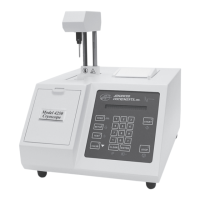1. Record the date and the change so that your previous data will be
correlatable.
2. If you select the Celsius scale, remember to multiply any Hortvet-
scaled data by 0.9656 before direct comparison. Beware: even if the
data in old literature is marked “Celsius”, it should be considered
Hortvet-correlated unless it is possible to determine otherwise (check
the standard-solution freezing points referenced; if 422 and 621,
Hortvet correlation may be inferred).
3. Likewise, make sure that any published regulations you use are for,
or have been converted to, the scale you are using. In the past, most
regulations have intended Hortvet correlation, whether “Celsius” was
specified or not. Verify by checking the standard solution freezing
points referenced; if 422 and 621 (or not specified at all), the regula-
tions probably were Hortvet correlated.
Internally, the 4250 accomplishes calibration in two steps. First it
records the raw means of the results of freezing point tests on standards
at each of the two calibration levels. Then it performs the necessary
conversion calculations and calibrates the display.
Calibration notes
• The Model 4250 will retain its previous calibration data until it com-
pletes a recalibration and the display reads “Calibration Complete”.
• Although it is possible for the 4250 to detect certain gross calibration
errors such as reversal of the standards, it remains the responsibility
of the operator to be sure to introduce accurate standards of the spec-
ified freezing point values.
• Pressing STOP during recalibration will cancel the current calibra-
tion test but allow calibration to be resumed with another sample.
Pressing STOP a second time will cancel recalibration and retain the
previous calibration.
• Good operating technique is as important during calibration as dur-
ing normal operation (see page 20, Repeatability Tips). If the cali-
41
Calibration

